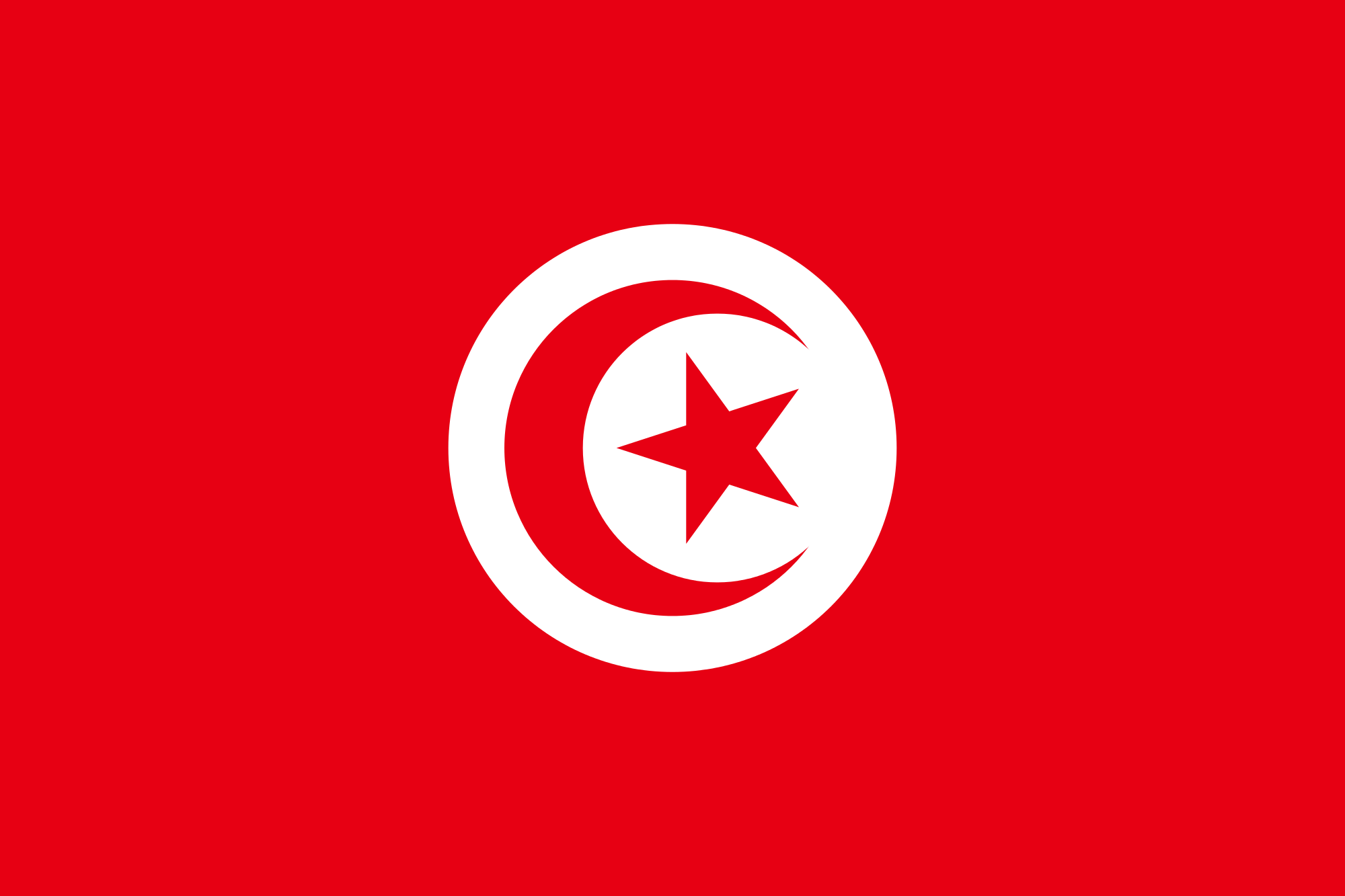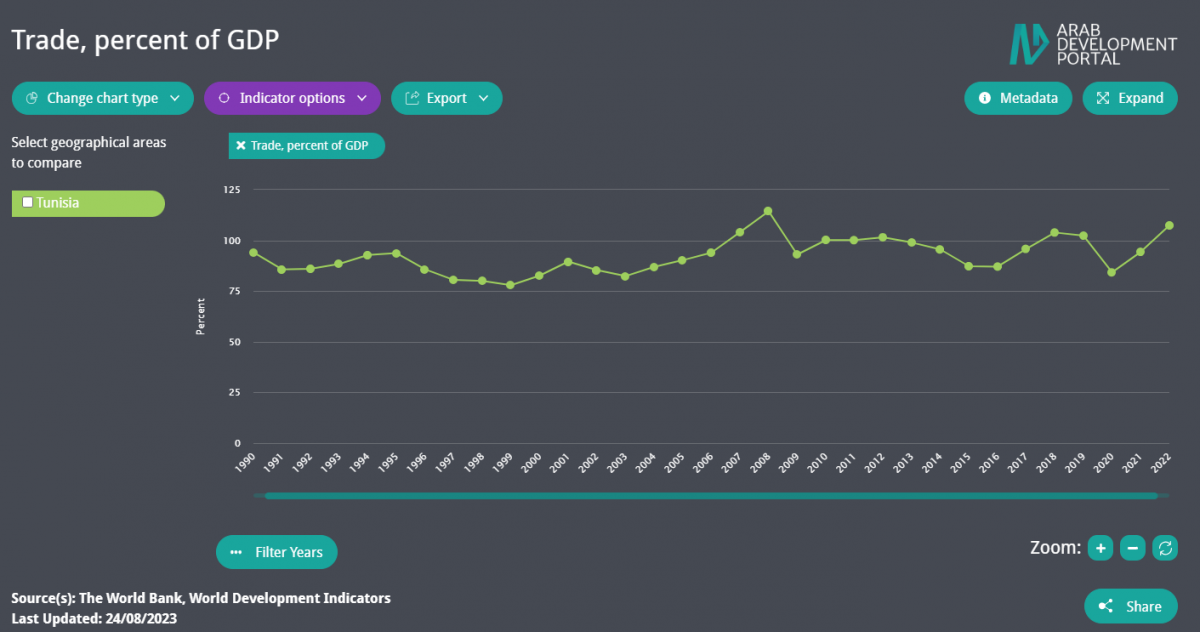 Tunisia
Tunisia
Tunisia’s population is estimated at 11.78 million in 2021[1] with a growing urban population percentage to 70.9 percent in 2022.[2] The population of Tunisia is aging: the proportion of the population below 30 years is 45.5 percent, down from 78.4 percent in 2000.[2] This is mainly due to a slightly decreasing fertility rate to around 2 [1] and considerable progress in the health sector in the last two decades, with life expectancy reaching 76.9 in 2022 according to the latest data published by the Tunisia Institute of Statistics (INS).
Tunisia’s Human Development Index (HDI) value for 2021 is 0.731 – which puts the country in the high human development category – positioning it at 97th out of 191 countries and territories. When adjusted for inequality, the country loses one-fifth (19.56 percent) of the score largely due to inequality in education.[3]
Following the uprising of 2011, Tunisia has been on a challenging development path. After real GDP increases of 2.2 percent and 2.6 percent in 2017 and 2018 respectively, the Tunisian economy grew at a sluggish 1 percent in 2019, mainly due to a contraction in the agricultural and fishing sector from 11.3 percent in 2018 down to 0.8 percent in 2019 due to expensive production prices. In 2020, it registered a negative growth of -8.6 then it reached 4.3 percent in 2021[1]
Public debt to GDP has been steadily increasing from 38.8 percent in 2010 up to a peak of 79.9 percent in 2021 and 79.4 percent in 2022.[4] According to the IMF, growth registered a drop to -8.8 percent in 2020, the lowest level since 1990 then it increased to 4.4 and 2.5 in 2021 and 2022 respectively. It is expected to drop to 1.3 percent in 2023. At the same time, public debt is expected to decrease to 77.8 percent of GDP in 2023.[5]
Unemployment remains high at 15.2 percent in the fourth quarter of 2022 percent, with female unemployment at 20.1 percent compared to 12.9 for men. The official poverty rate in Tunisia is at 15.2 percent, dating back to 2015, and the country is yet to conduct a new living conditions survey to produce updated figures.[1] According to the WHO latest available data, in 2020 government health expenditure was at 3.72 percent of GDP in Tunisia against a global average of 6.9. Consequently, out-of-pocket health expenditure (as a percent of current health expenditure) is at 36.4 percent, higher than the global average of 16.36 percent.[6][7]
The current account deficit exceeded -10 percent of GDP in 2018, then it declined to -5.9 in 2021.[5] Trade and economic integration have played significant roles in Tunisia’s economic development. In 2016, trade of goods and services reached its highest value since 1990 recording 114.3% of Tunisia’s GDP then it registered 107.4% in 2022 when the merchandise trade amounted to 96.9 percent of Tunisia’s GDP. [7]
This overview was last updated in October 2023. Priority is given to the latest available official data published by national statistical offices and/or public institutions.
Sources:
[1] National Institute of Statistics, Tunisia. 2023. [ONLINE] Available at: http://www.ins.tn/ [Accessed 29 October 2023].
[2] Population Division of the Department of Economic and Social Affairs of the United Nations Secretariat. 2023. World Urbanization Prospects. [ONLINE] Available at:
https://population.un.org/wup/ [23 October 2023].
[3] United Nations Development Programme (UNDP). 2023. Human Development Index. Country Profiles, Bahrain. [ONLINE] Available at: https://hdr.undp.org/data-center/documentation-and-downloads; https://hdr.undp.org/data-center/country-insights#/ranks [Accessed 25 October 2023].
[4] Ministry of Finance, Tunisia. 2023. [ONLINE] Available at: http://www.finances.gov.tn/ [Accessed 29 October 2023].
[5] International Monetary Fund. 2023. World Economic Outlook. [ONLINE] Available at: https://www.imf.org/en/Publications/SPROLLs/world-economic-outlook-databases#sort=%40imfdate%20descending [Accessed 24 October 2023].
[6] World Health Organization. 2023. Global Health Expenditure Database. [ONLINE] Available at: https://apps.who.int/nha/database/Select/Indicators/en [Accessed 15 October 2023].
[7] The World Bank. 2023. World Development Indicators. [ONLINE] Available at: https://databank.worldbank.org/data/source/world-development-indicators [Accessed 23 August 2023].
Data Highlights
-
Trade and economic integration have played significant roles in Tunisia’s economic development. In 2016, trade of goods and services reached its highest value since 1990 recording 114.3% of Tunisia’s GDP. In 2022, it registered 107.4%




